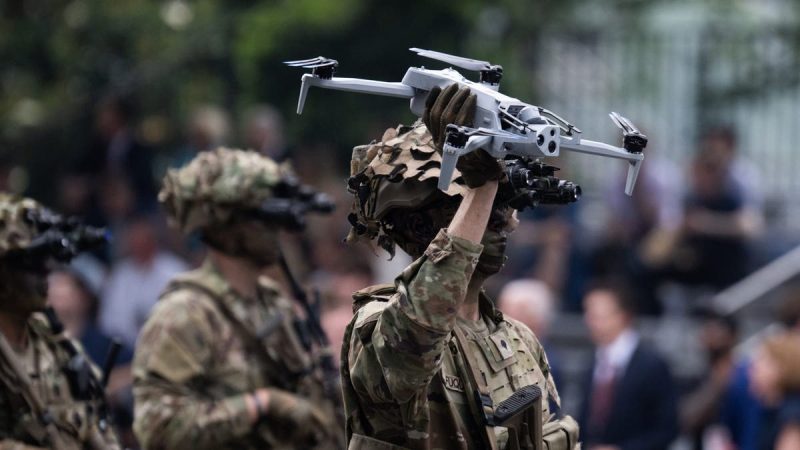: Defense Secretary Pete Hegseth has issued sweeping new orders to fast-track drone production and deployment, allowing commanders to procure and test them independently and requiring drone combat simulations across every branch of the military.
As part of an aggressive push to outpace Russia and China in unmanned warfare, ‘the Department’s bureaucratic gloves are coming off,’ Hegseth wrote. ‘Lethality will not be hindered by self-imposed restrictions… Our major risk is risk-avoidance.’
In a pair of memos first obtained by Fox News Digital, Hegseth rescinded legacy policies that he believes restricted innovation. For the first time, commanders with the rank of colonel or captain can independently procure and test drones, including 3D-printed prototypes and commercial-off-the-shelf systems, as long as they meet national security criteria.
They can also operate and train with drones immediately, bypassing traditional approval bottlenecks, and are even authorized to test non-lethal autonomous UAS in controlled environments.
‘Small UAS resemble munitions more than high-end airplanes,’ one instruction stated. ‘They should be cheap, rapidly replaceable, and categorized as consumable.’
The memos redefine small drones (Group 1 and 2) as consumables — not durable military assets — removing them from legacy tracking systems and simplifying acquisition.
To date, Hegseth said, the Department of Defense has ‘failed to field UAS [unmanned aircraft system] at scale and speed.’
‘Small UAS are such critical force enablers that they must be prioritized at the same level as major weapons systems.’
Commanders are instructed to work with the FAA to ‘remove inappropriate range restrictions, fast-track and expand spectrum approval, and establish a variety of UAS training areas that include live fire, combined arms, and swarm testing.’
Training ranges will be expanded, with three new UAS national test sites mandated within 90 days.
Weaponization, long a sticking point, will also move faster: Weapons Boards must now respond to drone arming requests within 30 days, and battery certifications must be processed within a week.
While America’s adversaries have a ‘head start’ in the world of small UAS, Hegseth expect the U.S. to establish domain dominance by the end of 2027.
‘Next year I expect to see this capability integrated into all relevant combat training, including force-on-force drone wars,’ Hegseth said, adding that investment methods outlined in Trump’s Unleashing American Drone Dominance executive order are being investigated.
The Pentagon will now build a ‘dynamic, AI-searchable Blue List,’ a digital platform cataloging approved drone components, vendors, and performance ratings. By 2026, this system will be run by the Defense Contract Management Agency (DCMA) and fueled by data from nightly AI retraining pipelines.
To jump-start the drone industry, the Pentagon will pursue advance purchase commitments, direct loans and other capital incentives within 30 days. Major purchases ‘shall favor U.S. companies,’ one memo said.
The move comes at a time when the lethal capabilities of modern drone warfare have been proven on the ground in Ukraine and in the Middle East.
Since Russia launched its full-scale invasion of Ukraine in 2022, drones have redefined modern warfare. Both Ukrainian and Russian forces have used unmanned aerial systems (UAS) to reshape tactics on the battlefield and gather real-time intelligence. What started as basic surveillance and artillery targeting has rapidly evolved into lethal deployments of so-called ‘kamikaze drones’ — loitering munitions designed to hover before zeroing in on targets deep behind enemy lines.
READ THE MEMO BELOW. APP USERS: CLICK HERE
Among the most prolific and controversial of these is Iran’s Shahed-136, a low-cost, GPS-steered drone supplied to Russian forces. Fired in large formations, the Shaheds have been instrumental in attacks on Ukrainian energy infrastructure and residential zones, often bypassing expensive missile systems at a fraction of the cost. In response, Ukraine has modified commercial drones to deliver explosive payloads against Russian trenches, vehicles, and naval targets in the Black Sea.
Earlier this month, Israel relied heavily on drone strikes during Operation Rising Lion, coordinating them with manned air missions to target high-level Iranian military officials and nuclear infrastructure. Iran retaliated with its own barrage of drones.
The rapid adoption of drones has triggered major shifts in doctrine, spurred the development of electronic countermeasures and ignited debate over whether drones are poised to overtake manned aircraft as the dominant force in future air combat.
